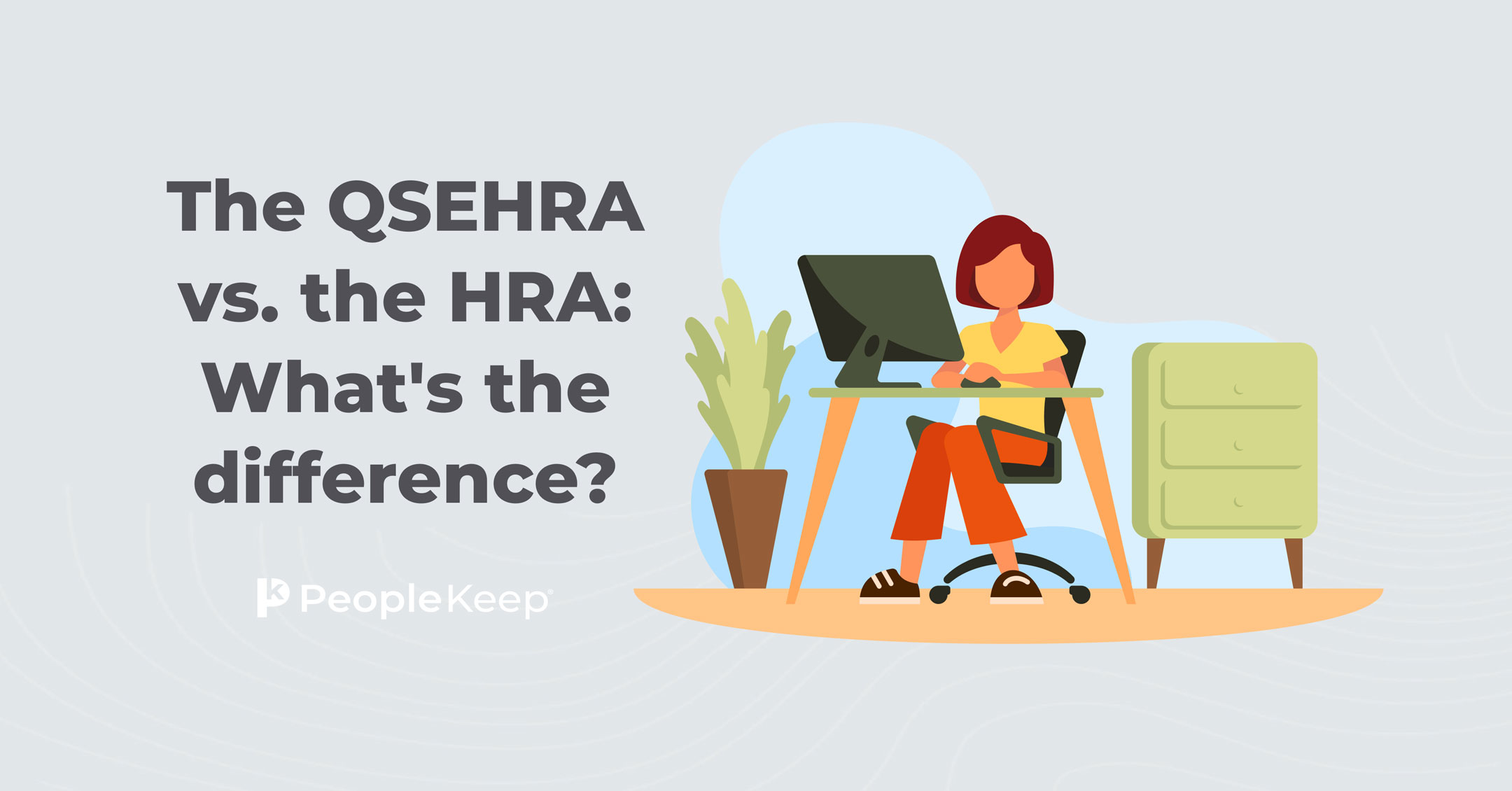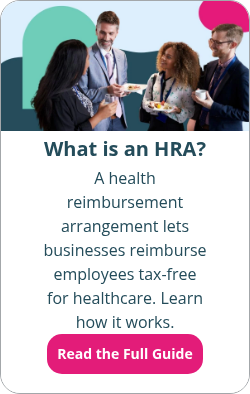How HRAs affect premium tax credit eligibility
By Elizabeth Walker on May 13, 2024 at 10:00 AM
With a stand-alone health reimbursement arrangement (HRA), employers can reimburse employees tax-free for their healthcare costs. Unlike traditional group health insurance, HRAs allow employees to choose individual health coverage that meets their needs and use their employer-contributed monthly allowance to pay for more than 200 out-of-pocket medical expenses, including individual plan premiums.
Employees shopping for individual coverage can also get help with the cost of their insurance premiums through premium tax credits. The Affordable Care Act (ACA) created premium tax credits to discount individual health plans purchased on public health exchanges. If employees qualify for tax credits and are offered an HRA by their employer, there's some extra coordination that must happen.
How your employees must account for their premium tax credits will vary depending on what type of HRA you offer. In this blog, we’ll walk you through how premium tax credits work with stand-alone HRAs.
Takeaways from this blog post:
- Premium tax credits, or health insurance premium subsidies, provide discounts on the costs of health coverage for low-income individuals and families. Premium tax credit eligibility depends on household income, number of dependents, and location.
- Employees offered a QSEHRA or ICHRA that meets the ACA’s definition of “affordability” cannot collect any premium tax credits. However, if either HRA is considered “unaffordable”, they can collect tax credits with some additional coordination.
- Offering a health stipend as an alternative to an HRA can allow employees to receive their premium tax credits without affecting their eligibility, depending on the amount you provide.
What is a premium tax credit?
The federal government created premium tax credits, also known as health insurance premium subsidies, in 2014 to provide discounts for health insurance to lower-income individuals and families. These credits and other federal subsidies are only available to those who purchase marketplace coverage through the federal Health Insurance Marketplace or a state-based exchange. Individuals can’t get tax credits for plans they purchase from a private exchange.
These federal tax credits alleviate the financial stress of purchasing an individual health insurance plan by allowing recipients to apply the tax credit to their monthly premium payment in advance or by getting it with their income tax refund, thus lowering the total cost of health insurance. If you receive a tax credit every month instead of waiting to file your taxes, these are called advance premium tax credits (APTC).
Here’s how it works: Individuals who complete their initial application for health insurance coverage during a special or open enrollment period provide a quick estimate of their yearly income amount. If they qualify for premium tax credits, they can use any portion of the tax credit to lower their monthly health insurance premiums. Eligible individuals can even pay the APTCs directly to their insurance company.
Individuals who use fewer APTCs than they qualify for get the rest back on their tax return. However, if they take more advance payments than they should’ve received, they’ll have to repay any excess. Individuals can reconcile their tax credits with Form 8962.
So, what are the APTC eligibility criteria? Whether or not an individual qualifies for a tax credit depends on several key factors, including where they live, their household income level, and their number of dependents. Your employees can determine if they qualify for these subsidies using KFF’s Health Insurance Marketplace Calculator1.
How do premium tax credits work with a QSEHRA?
Employees who receive monthly allowances through a qualified small employer HRA (QSEHRA) can coordinate their health benefits with their premium tax credits. However, premium credit eligibility depends on whether their QSEHRA is affordable.
If your QSEHRA benefit is affordable for a given month, an employee can’t collect their tax credits for that month. If your benefit isn’t considered affordable for one or more months, they can still collect their credits if they qualify. But they must reduce their subsidy by the amount of their QSEHRA allowance.
A QSEHRA is affordable in 2026 if an employee isn’t paying more than 9.96% of their actual income for the second-lowest-cost silver plan premium on the Marketplace after they factor in their QSEHRA allowance amount. The second-lowest-cost silver plan is typically referred to as the benchmark plan.
It’s important to note that employees must have a health insurance policy that meets minimum essential coverage (MEC) to participate in the QSEHRA. Participants can’t opt out of the benefit to collect their full premium tax credit to reduce the cost of health coverage.
How do premium tax credits work with an ICHRA?
Unlike the QSEHRA, employees participating in an individual coverage HRA (ICHRA) can’t collect any amount of their premium tax credits. However, the federal government provided some flexibility to the ICHRA rules so employees can be sure they’re getting the best possible benefit.
With an ICHRA, employees have a choice: they can participate in the HRA and waive their premium tax credits, or they can opt out of their ICHRA and collect premium tax credits if the ICHRA is considered unaffordable.
Similar to a QSEHRA, the federal government considers an ICHRA affordable if the employee pays at most 9.96% of their household income for health coverage in 2026. However, the ICHRA uses the lowest-cost silver plan on the local exchange as a benchmark plan instead of the second-lowest cost silver plan.
Since you likely don’t know your employees’ household incomes, you can use safe harbors, like the federal poverty level income safe harbor, to help determine if your ICHRA is affordable.
Employees can waive their tax credits and participate in an ICHRA. But, employees may only opt out of their ICHRA if it’s considered unaffordable. When a new plan year is coming up, employees can opt in or out of the ICHRA for the following year. However, they can’t make changes midyear. Once they opt out, they can’t participate for that entire plan year.
Remember, employees must have a qualified individual policy that provides at least minimum essential coverage to participate in the ICHRA benefit.
HRA premium tax credit comparison chart
Take a look at this chart to quickly compare how to coordinate your premium tax credit with a QSEHRA and an ICHRA:
|
Premium tax credit eligibility |
Premium tax credit coordination |
Is an opt-out option available? |
|
|
QSEHRA |
Yes, if they qualify. |
Employees can collect their premium tax credit based on monthly affordability. If the QSEHRA is unaffordable, employees can collect their tax credits. But they must reduce their subsidy by the amount of their allowance. |
No. |
|
ICHRA |
No. |
N/A - Employees must collect their premium tax credit or their ICHRA allowance based on affordability. |
Yes. |
How a health stipend can benefit organizations with APTC-eligible employees
Suppose your organization has employees who receive premium tax credits, and you want to offer them a health benefit that doesn’t affect their APTC eligibility. In that case, you can offer a health stipend.
Unlike an HRA, the Internal Revenue Service (IRS) considers health stipends taxable income, so you must include their stipend amounts on your employees’ W-2s (contact your tax advisor for professional assistance if you need guidance).
Because there are no tax advantages to using a health stipend, avoiding IRS double-dipping penalties, employees can use their health benefit and still receive their premium tax credits as long as the stipend doesn’t push their household income past the eligibility limit.
However, you can’t require your employees to submit proof of purchase for items or services in IRS Publication 502, nor can you force them to provide proof of payment for a health insurance policy. A stipend also doesn’t satisfy the ACA’s employer mandate for organizations with 50 or more full-time equivalent employees (FTEs), meaning these organizations would need to supplement them with an ICHRA, switch to a group plan, or face potential penalties.
When offering a stipend, it’s essential to remind your employees that they are responsible for paying any federal income taxes associated with their benefit and submitting an accurate tax return.
Conclusion
When offering your employees an HRA, there are important guidelines to remember when making your premium tax credit work with a health benefit.
A health stipend is a good alternative to ensure your employees maintain their full APTC eligibility. But if you’re looking for a more robust benefit to help your employees with their monthly premium payments and other out-of-pocket expenses, following the guidelines in this article on coordinating an HRA with premium tax credits is an excellent first step.
This blog article was originally published on February 21, 2019. It was last updated on May 13, 2024.
Check out more resources
See these related articles

Can I have an HRA and an FSA at the same time?
Learn if you can have an HRA and an FSA at the same time. Understand the rules, benefits, and how these accounts can work together for healthcare costs.

Types of HRAs
Explore the different types of HRAs, including ICHRA, QSEHRA, and group coverage HRA. Learn how each works and which is right for your organization.

The QSEHRA vs. the HRA: What's the difference?
Confused about the difference between an HRA and a QSEHRA? This guide explains how a QSEHRA compares to other types of HRAs.



